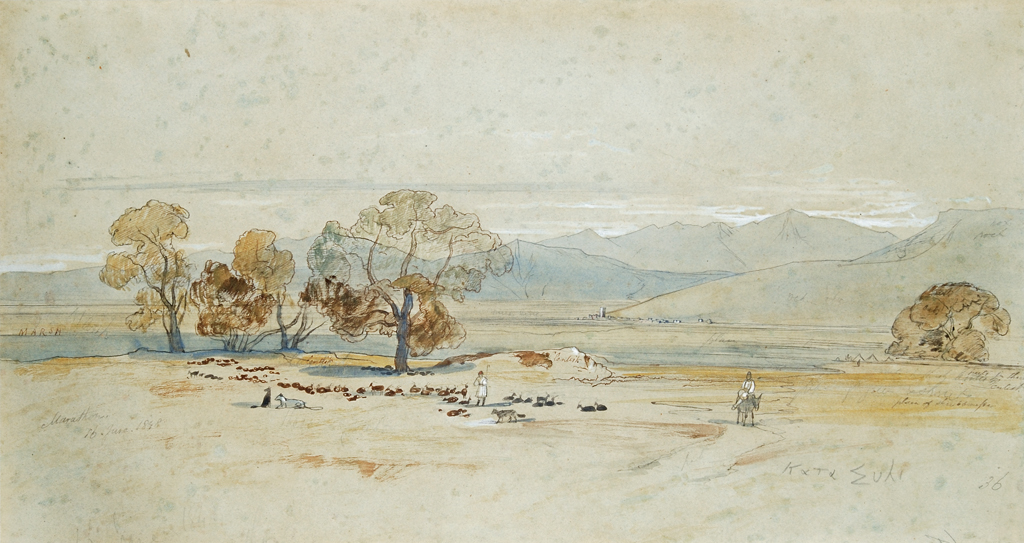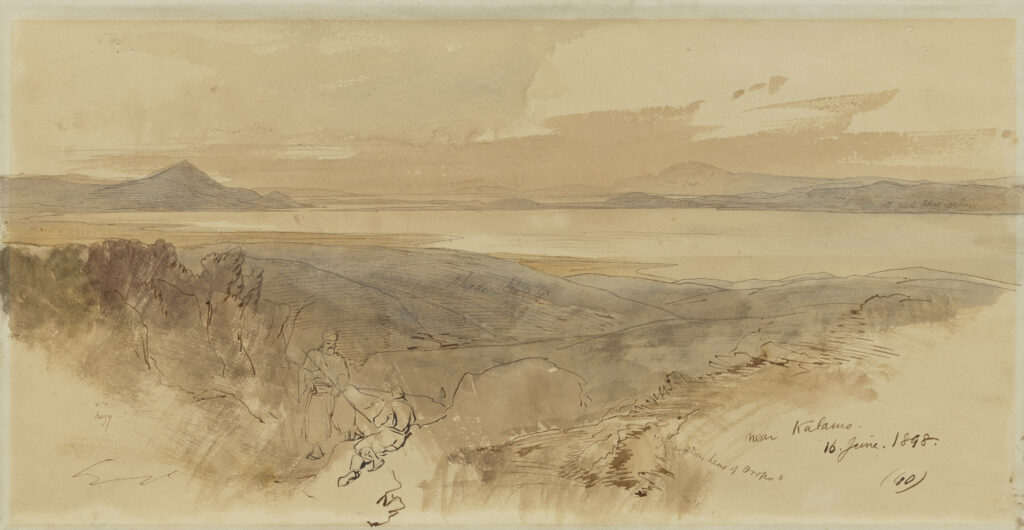Friday 16 June
Thank God, I slept a good deal, from having been so tired, but woke in great pain. Difficult task to wash and dress. No perceptible power as yet of moving my arm, though I suffer less pain. Good breakfast. Janni not ready till 5.30, when we left. Walked, for I could not mount my horse on account of my arm. Shady side of hill about Marathon. Edge of marsh where Persians was drownded. Fine black, but savage, dogs. Superb scattered trees. {sketch 36} Struck inland — a monotonous, hilly plain; oaks here and there. Sun hot; arm very bad; tired and ill.

VIS4489, reproduced by kind permission of Museums Sheffield
9 a.m. came in sight of Fort of Ramnus. Drew, while C. M. C. bathed. Tremendous heat. Then, at last, with great pain, mounted and rode up to the foundations of Temple. On by ravines, with wood and grey rocks. By 1 p.m. at Varnava, a pretty village, with noble views. Dinner in tent — excellent. Directly afterwards drew — great heat. Arm a thought better. At 3 p.m. start again. Beautiful ravines — climb hills — Oleanders, blooming Acanthus (narrow leaved). Turn towards Euboea — exquisite views!
Down, down, down to Kalamos. After a long, long road, arrived at the Scala di Oripò. Khan. Mice! fleas! Tea — eggs with a fish-like flavour. Much laughter and impromptu verses:
The Hens of Oripò
The aged hens of Oripò
They tempt the stormy sea;
Black, white and brown, they spread their wings,
And o’er the waters flee.
And when a little fish they clutch
Athwart the wave so blue,
They utter forth a joyful note —
“A cock a doodle doo!” (oo).
O! Oo! Oripò-oo!
The hens of Oripò!The crafty hens of Oripò
They wander on the shore,
Where shrimps and winkles pick they up
And carry home a store.
For barley, oats and golden corn
To eat they never wish;
All vegetable food they scorn,
And only seek for fish.
O! Oo! Oripò-oo!
The hens of Oripò!The wily hens of Oripò,
Black, white and brown and grey,
They don’t behave like other hens,
In any decent way.
They lay their eggs among the rocks,
Instead of in the straw.
. . . . . . . . . . . . . . . . . .
. . . . . . . . . . . . . . . . .The nasty hens of Oripò,
With ill-conditioned zeal
All fish defunct they gobble up
At morn or evening meal,
Whereby their eggs, as now we find,
. . . . . . . . . . . . . . . . .
A fishlike, ancient smell and taste
Unpleasant doth pervade.
O! Oo! Oripò-oo!
The hens of Oripò!

Courtesy of the Art Gallery of South Australia, Adelaide
16 June: Three chief sketches of this day’s work mark our route, and the points which caught his eye and made the chief impression on him.
(a) Rhamnus on the ascent of the ridge above Marathon, at the head of narrow gorge falling down to the seashore, and to ruins of the old fort there. In the foreground are the white blocks of marble of the Temple of Nemesis, among “cushions of green lentisk,” on each side of the gorge. The sea and shore and mountains of Euboea are opposite in the middle and furthest distance.
(b) Next, the view from Varnava, on the crest of the pine-clad ridge, looking over the upland of Attica on one side, where Parnes and Pentelicus join their roots on the site of Deceleia and the present gardens and woods of Tatoi,[20] and on the other hand fall down upon the woodland slope and plains of the Attic shore to the distances of Euboea, on the other side of the Euripus, Mt Dirphe, with its lofty, conical head, tipped with snow, always prominent in the landscapes from this shore.
(c) Thirdly, Kalamos, the third sketch today, lower down on the slope of this mountain ridge where the view towards Euboea is laid out more distinctly and with a wider range. This is one of Lear’s most topographical sketches at this time. It might almost have been drawn in accordance with Leake’s description,[21] commanding a good view of the surrounding parts of Attica and Boeotia and of the opposite coast of Euboea. Taken from the heights above the Channel in face of the deep gulf of Aliveri in Euboea, it ranges up the great middle plain of the island, across to Kumi on the Eastern shore of the island and again upwards on the Western coast as far as Eretria and the heights above Chalcis and beyond, to the cliffs under Kandile. This wonderful panorama comes out in Lear’s picture in the rich purple of a setting sun.
From Kalamos we came down to Oripò and the Scala of Oripò, Lear sketching, through a foreground of pine wood, the channel of Euboea, and Eretria, its hill fort, and the mountains opposite; and we put up for the night at the Khan at the Scala of Oripò. Here men were fishing off the shore.
[20] Ottoman name for ancient (and modern) Deceleia; Church is referring to the “gardens and woods” of the Greek royal family’s summer palace, built in the 1870s.
[21] William Martin Leake, Travels in Northern Greece, 4 vols (1835), 2, 438-9.
